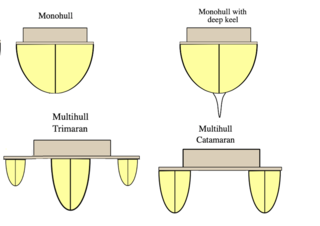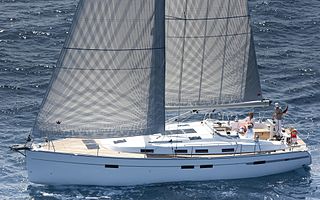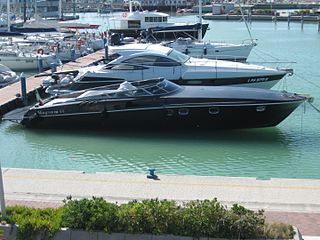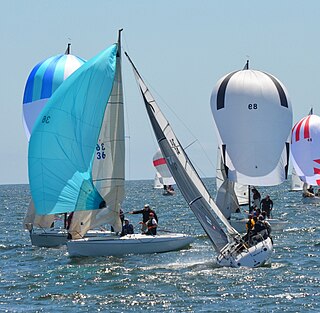
A go-fast boat is a small, fast power boat designed with a long narrow platform and a planing hull.

A multihull is a boat or ship with more than one hull, whereas a vessel with a single hull is a monohull. The most common multihulls are catamarans, and trimarans. There are other types, with four or more hulls, but such examples are very rare and tend to be specialised for particular functions.

Offshore powerboat racing is a type of racing by ocean-going powerboats, typically point-to-point racing.

Sailing employs the wind—acting on sails, wingsails or kites—to propel a craft on the surface of the water, on ice (iceboat) or on land over a chosen course, which is often part of a larger plan of navigation.

A yacht is a sailing or power vessel used for pleasure, cruising, or racing. There is no standard definition, though the term generally applies to vessels with a cabin intended for overnight use. To be termed a yacht, as opposed to a boat, such a pleasure vessel is likely to be at least 33 feet (10 m) in length and may have been judged to have good aesthetic qualities.

A catamaran is a watercraft with two parallel hulls of equal size. The distance between a catamaran's hulls imparts resistance to rolling and overturning. Catamarans typically have less hull volume, smaller displacement, and shallower draft (draught) than monohulls of comparable length. The two hulls combined also often have a smaller hydrodynamic resistance than comparable monohulls, requiring less propulsive power from either sails or motors. The catamaran's wider stance on the water can reduce both heeling and wave-induced motion, as compared with a monohull, and can give reduced wakes.

Stefano Casiraghi was an Italian offshore powerboat racer, socialite, and businessman. He was the second husband of Princess Caroline of Monaco; he died during a racing accident defending his 1990 Class 1 World Powerboat Championship title.

Planing is the mode of operation for a waterborne craft in which its weight is predominantly supported by hydrodynamic lift, rather than hydrostatic lift (buoyancy).

Hobie Cat is a company that manufactures sailing catamarans, surfboards, sailboats, kayaks, stand-up paddle boards, and pedalboards as the Hobie Cat Company. It was founded in 1961 by Hobart Alter, who originally manufactured surfboards. Its line of products has included more than twenty sailing craft, plus a variety of other watercraft.

The Formula 1 Powerboat World Championship is an international motorboat racing competition for powerboats organised by the Union Internationale Motonautique (UIM) and promoted by H2O Racing, hence it often being referred to as F1H2O. It is the highest class of inshore powerboat racing in the world, and as such, with it sharing the title of F1, is similar to Formula One car racing. Each race lasts approximately 45 minutes following a circuit marked out in a selected stretch of water, usually a lake, river, dock, or sheltered bay.
A mast-aft rig is a sailboat sail-plan that uses a single mast set in the aft half of the hull. The mast supports fore-sails that may consist of a single jib, multiple staysails, or a crab claw sail. The mainsail is either small or completely absent. Mast-aft rigs are uncommon, but are found on a few custom, and production sailboats.

A sailing hydrofoil, hydrofoil sailboat, or hydrosail is a sailboat with wing-like foils mounted under the hull. As the craft increases its speed the hydrofoils lift the hull up and out of the water, greatly reducing wetted area, resulting in decreased drag and increased speed. A sailing hydrofoil can achieve speeds exceeding double and in some cases triple the wind speed.

A sailing yacht, is a leisure craft that uses sails as its primary means of propulsion. A yacht may be a sail or power vessel used for pleasure, cruising, or racing. There is no standard definition, so the term applies here to sailing vessels that have a cabin with amenities that accommodate overnight use. To be termed a "yacht", as opposed to a "boat", such a vessel is likely to be at least 33 feet (10 m) in length and have been judged to have good aesthetic qualities. Sailboats that do not accommodate overnight use or are smaller than 30 feet (9.1 m) are not universally called yachts. Sailing yachts in excess of 130 feet (40 m) are generally considered to be superyachts.

The Magnum Marine Corporation is an American builder of performance and luxury yachts based in Miami, Florida.
An aerodynamically alleviated marine vehicle (AAMV) is a high speed marine vehicle configuration that uses aerodynamically generated forces (lift) to 'alleviate' its weight. The advantage is that the hydrodynamic lift required to sustain the weight of the vehicle is diminished, leading to a diminished hydrodynamic drag. The vehicle is in constant contact with the water, therefore the aerodynamic surfaces operate in ground effect. The name derives from the "Aerodynamic Alleviation Concept", presented by L.J. Doctors to illustrate the positive effect of using a wing-like superstructure on a catamaran configuration.

Forces on sails result from movement of air that interacts with sails and gives them motive power for sailing craft, including sailing ships, sailboats, windsurfers, ice boats, and sail-powered land vehicles. Similar principles in a rotating frame of reference apply to windmill sails and wind turbine blades, which are also wind-driven. They are differentiated from forces on wings, and propeller blades, the actions of which are not adjusted to the wind. Kites also power certain sailing craft, but do not employ a mast to support the airfoil and are beyond the scope of this article.
The UIM Class 1 World Powerboat Championship is an international motorboat racing competition for powerboats organized by the Union Internationale Motonautique (UIM). It is the premier class of offshore powerboat racing in the world.

Inshore powerboat racing is a form of water-based motorsport using powerboats in sheltered or inland stretches of water, including lakes, rivers, docks and sheltered bays. It is often referred to as circuit powerboat racing because of the frequency of inshore races to use the format of a circuit loop, around which boats race for a number of pre-determined laps.

The Hobie 17 is an American catamaran that was designed by John Wake as a single-handed racer and first built in 1985.
The Phantom 14 is an American sailing dinghy that was designed by Jack Howie as a racer and first built in 1977. It is a board sailboat, similar to the Sunfish.















